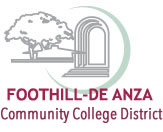why Switch to Area Elections?
On this page
- Background about why the board decided to make this change
- Link to Notice of Violation of California Voting Rights Act
- Link to the resolution announcing the board's intention to switch to area elections
- Link to resolution authorizing switch to trustee area elections starting in 2022
- Link to frequently asked questions
Why change the election system?
The Foothill-De Anza Community College District has elected trustees at-large since
its founding in 1957. Under this system, the top vote-getters in districtwide voting
are elected to the open seats.
Switching to trustee areas involves dividing the district into five trustee areas of roughly equal population size, based on 2020 Census data, and people in each of the areas electing a trustee. This system is intended to provide more direct representation and make it easier and less expensive for people who live in each trustee area to run for a seat on the Board of Trustees.
At the most basic level, the purpose of moving to trustee area elections is to create fairer representation, equalize voting strength, and create equitable distribution of political power.
The first of five public hearings related to the formation of trustee areas were held by the board on Sept. 13 and Oct. 4, 2021. These initial hearings focused on identifying "communities of interest" to provide information for creating draft trustee area boundary maps.
In November 2021, the district posted for public review and comment three draft maps prepared by consultant Redistricting Partners. At a Dec. 13 public hearing, the board voted to move forward with Draft Map A and Draft Map C. At a Jan. 10 public hearing, the board voted to move forward with Draft Map A to consider for adoption at its meeting of Feb. 14, 2022. On Feb. 14, 2022, concluding an extensive public process, the Board of Trustees adopted a resolution switching to a trustee area election system from an at-large election system, adopted Map A to establish election boundaries for five trustee areas, and determined which two trustee areas will hold elections in 2022 and which three will elect in 2024.
The board’s decision to transition to trustee area elections followed a claim submitted in 2019 by an attorney on behalf of a district voter, Sebastian Aguilar. The notice claimed that the district’s at-large election system may violate Mr. Aguilar’s rights under the California Voting Rights Act (CVRA) because of allegedly racially polarized voting in the district and in jurisdictions that make up the district.
Racially polarized voting is characterized by differences in voting patterns that correlate to race, religion, national origin, or membership in any other “protected class” that historically hasn’t had equal opportunity to participate in the political process by voting. When there is racially polarized voting, voters in a protected class prefer candidates or ballot measures that are different from those preferred by the rest of the voters.
In a resolution stating its intent to move to trustee area elections, the board disputes Mr. Aguilar’s claim that at-large trustee elections in the Foothill-De Anza Community College District are characterized by racially polarized voting and notes that trustees of diverse races and ethnicities are elected to the Board of Trustees.
However, recognizing that the California Voting Rights Act strongly favors area elections over at-large elections and that it is intended to protect voting rights, the Board of Trustees opted to avoid the expense and uncertainty of litigation and voted to switch to trustee area elections beginning with the November 2022 general election to avoid being sued.
In recent years, dozens of legal claims similar to Mr. Aguilar’s have been lodged against school districts, special districts, and cities and counties throughout California to promote area elections. Most jurisdictions have agreed to make the change rather than engage in litigation. At the time the board made the decision to switch to trustee area elections, no other public agency was known to have successfully defended against a California Voting Rights Act challenge.
Jurisdictions that lose lawsuits brought under the California Voting Rights Act are subject to paying attorneys' fees, court costs and expert witness fees for the prevailing party.

